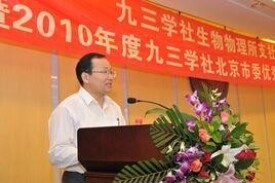范祖森
范祖森
范祖森中科院研究員 中科院“百人計劃”獲得者男,研究員,博士生導師。
1998年在上海第二醫科大學獲得免疫學博 士學位后,到中國科學院上海生物化學研究所分子生物學國家重點實驗室從事博士后研究,被晉陞為副研究員。隨後到美國哈佛大學醫學院血液研究中心繼續從事博士后研究,作為主要骨幹全過程參加了細胞毒性T淋巴細胞(CTL)殺傷腫瘤機理的研究,闡明了顆粒酶A介導靶細胞凋亡的新機制。論文以第一作者的身份發表在Cell, Nature Immunology 和Mol. Cell. Biol. 等雜誌上。Cell 和Nature Immunology上的論文均附有同行專家評論,在Science上作為免疫學的重要發現做過介紹,受到同行的高度重視。受Current Opinion Immunology 邀請撰寫了該研究領域的綜述評論。多年來一直從事分子生物學和免疫學研究工作,發表論文30餘篇。去年7月被晉陞為哈佛大學醫學院講師和血液研究所副研究員。上海第二醫科大學客座教授和上海市外國專家局外聘專家。美國分子生物學學會會員和美國免疫家學會會員。作為中國科學院2004年度“百人計劃”引進回國工作。研究方向:細胞周期調控與細胞癌變機制;組蛋白修飾與基因轉錄調控;細胞毒性 T淋巴細胞(CTL) 誘導的腫瘤殺傷機理;腫瘤及病毒感染性疾病的免疫靶向治療。
2013年1月30號范祖森課題組從事腫瘤幹細胞、免疫細胞發育分化及腫瘤靶標發現與腫瘤個體化治療等領域的研究,主要研究方向為免疫細胞譜系建立的信號轉導、抗腫瘤免疫機制、腫瘤幹細胞鑒定及干預機制、腫瘤新靶標的鑒定與抗體靶向藥物研發等領域的研究,課題組經過多年的研究積累業已形成優秀的研究平台和科研文化氛圍。現因工作需要特招聘1-2名博士后/副研究員。
受聘者應在細胞生物學、分子生物學、免疫學、幹細胞生物學、生物醫藥等相關領域獲得博士學位,在一流實驗室接受過博士或博士后訓練,並具有良好的研究論文發表和英語寫作交流能力,要求具有良好的組織協調能力。
應聘者將根據自己的研究興趣結合實驗室的研究領域開展前瞻性研究,並經過2-3年科學訓練使其達到國際先進水平,達成自己的科學夢想。
1. 免疫細胞清除腫瘤和病毒的免疫效應機制
2. 免疫細胞的活化和譜系建立的時相遺傳調控機制
3. 腫瘤幹細胞、腫瘤標誌物、腫瘤的個體化藥物研發
1. Shuo Wang*, Pengyan Xia*, Buqing Ye, Guanling Huang, Jing Liu, Zusen Fan*. Transient activation of autophagy via Sox2-mediated suppression of mTOR is an important early step in reprogramming to pluripotency. Cell Stem Cell
2. Pengyan Xia1*, Shuo Wang1*, Ying Du1, Zhenao Zhao2, Lei Shi1, Lei Sun3, Guanling Huang1, Buqing Ye1, Chong Li1, Zhonghua Dai1, Ning Hou4, Xuan Cheng4, Qingyuan Sun2, Lei Li2, Xiao Yang4+, Zusen Fan*. WASH inhibits autophagy through suppression of Beclin 1 ubiquitination
3. Buqing Ye1*, Zhonghua Dai1*, Benyu Liu1, Rui Wang1, Chong Li1, Guanling Huang1, Shuo Wang1, Pengyan Xia1, Xuan Yang1, Kazuhiko Kuwahara2, Nobuo Sakaguchi2, Zusen Fan*
4. Liu S, Zhang H, Li M, Hu D, Li C, Ge B, Jin B, Fan Z*. Recruitment of Grb2 and SHIP1 by the ITT-like motif of TIGIT suppresses granule polarization and cytotoxicity of NK cells
5. Wang L, Li Q, Wu L, Liu S, Zhang Y, Yang X, Zhu P, Zhang H, Zhang K, Lou J, Liu P, Tong L, Sun F, Fan Z*. Identification of SERPINB1 As a Physiological Inhibitor of Human Granzyme H, J
6. Wang S, Xia P, Shi L, Fan Z*, FADD cleavage by NK cell granzyme M enhances its self-association to facilitate procaspase-8 recruitment for auto-processing leading to caspase cascade
7. Zhong C, Li C, Wang X, Toyoda T, Gao G, Fan Z*, Granzyme K inhibits replication of influenza virus through cleaving the nuclear transport complex importin alpha1/beta dimer of infected host cells
8. Tang H, Li C, Wang L, Zhang H, Fan Z*,Granzyme H of cytotoxic lymphocytes is required for clearance of the hepatitis B virus through cleavage of the hepatitis B virus X protein, J Immunol
9. Wang L, Zhang K, Wu L, Liu S, Zhang H, Zhou Q, Tong L, Sun F, Fan Z*, Structural insights into the substrate specificity of human granzyme H: the functional roles of a novel RKR motif
10. Guo Y, Chen J, Shi L, Fan Z*. VCP cleavage by granzyme K disrupts endoplasmic reticulum associated protein degradation to force tumor target cell death
11. Hu D, Liu S, Shi L, Li C, Wu L, Fan Z. Cleavage of survivin by Granzyme M triggers degradation of the survivin-X-linked inhibitor of apoptosis protein (XIAP) complex to free caspase activity leading to cytolysis of target tumor cells
12. Hua G, Wang S, Zhong C, Xue P, Fan Z*. Ignition ofp53 bomb by granzyme K sensitizes tumor cells to NK cell-mediated cytolysis
13. Zhang H, Zhong C, Shi L, Guo Y, Fan Z*. Granulysin induces cathepsin B release of lysosomes of target tumor cells to target mitochondria through processing of Bid
14. Wu L, Wang L, Hua G, Liu K, Yang X, Zhai Y, Bartlam M, Sun F, Fan Z*. Structural Basis for Proteolytic Specificity of the Human Apoptosis-Inducing Granzyme M
15. Shi L, Wu L, Wang S, Fan Z*. Granzyme F induces a novel death pathway characterized by Bid-independent cytochrome c release without caspase activation
16. Hou Q, Zhao T, Zhang H, Lu H, Zhang Q, Sun L, Fan Z*. Granzyme H induces apoptosis of target tumor cells characterized by DNA fragmentation and Bid-dependent mitochondrial damage
17. Guo Y, Chen J, Zhao T, Fan Z*. Granzyme K degrades the redox/DNA repair enzyme Ape1 to trigger oxidative stress of target cells leading to cytotoxicity
18. Hua G, Zhang Q, Fan Z*. Heat shock protein 75 (TRAP1) antagonizes reactive oxygen species generation and protects cells from granzyme M-mediated apoptosis. J Biol Chem
19. Zhao T, Zhang H, Guo Y, Fan Z*. Granzyme K directly processes Bid to release cytochrome c and endonuclease G leading to mitochondria- dependent cell death
20. Zhao T, Zhang H, Guo Y, Zhang Q, Lu H, Hou Q, Hua G, Fan Z*. Granzyme K Induces rapid caspase-independent cell death with apoptotic nuclear morphology and single-stranded DNA nicks
21. Fan Z*, Yu P, Wang Y, Lee Y, Wang Y, Fu M, Liu W, Sun Y, Fu YX. NK activation by LIGHT primes tumor specific CD8+ T cell immunity to reject established tumors
22. Lu H, Hou Q, Zhao T, Zhang H, Zhang Q, Fan Z*. Granzyme M directly cleaves ICAD to unleash caspase-activated DNase leading to DNA fragmentation
23. Fan Z*, Zhang H, Zhang Q. Tumor suppressor pp32 represses cell growth by inhibiting transcription by blocking acetylation and phosphorylation of hostone H3 and initiating its proapoptotic activity
24. Fan Z*, Zhang Q. Molecular mechanisms of lymphocyte-mediated cytotoxicity. Cell Mol Immunol
25. *Fan Z. CTL-mediated killing mechanism against cancers. J
26. Fan Z, Beresford PJ, Oh DY, Zhang D, Lieberman J*. The tumor metastasis suppressor NM23-H1 is a granzyme A-activated DNase that nicks DNA during CTL-mediated apoptosis and the nucleosome assembly protein SET is its inhibitor
27. Fan Z, Beresford PJ, Zhang D, Xu Z, Novina CD, Yoshida A, Pommier Y, Lieberman J*. Cleaving the oxidative repair protein Ape1 enhances cell death mediated by granzyme A
28. Lieberman J*, Fan Z*. Nuclear war: the Granzyme A-bomb. Curr Opin Immunology
29. Fan Z, Beresford PJ, Zhang D, Lieberman J*. HMG2 interacts with the nucleosome assembly protein SET and is a target of the cytotoxic T- lymphocyte protease granzyme A
30. Beresford PJ, Zhang D, Oh DY, Fan Z, Greer EL, Russo ML, Jaju M, Lieberman J. Granzyme A activates an endoplasmic reticulum-associated cas Caspase-independent nuclease to induce single-stranded DNA
